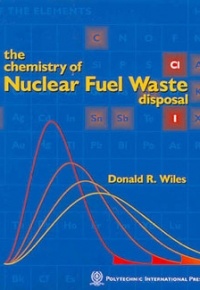The chemistry of nuclear fuel waste disposal
Auteur : WILES Donald R.

1- Introduction
Electric Power in the World. History of Nuclear Power. Nuclear Power Reactors in the World. What is the Problem?. Current Storage of Nuclear Waste. Current Scientific Opinion on Disposal. Procedural Decisions in Canada. Impact Assessment. The Radionuclides and Their Behaviour. The Canadian Proposal. Topics not included in this book
2- Nuclei and Radioactivity
The Structure of the Nucleus. Neutrons, Protons and Nuclei. Nuclear Mass and Size. Nuclear Energy and Mass. Stable and Unstable Nuclei. The Phenomena of Radioactivity. In Summary. Interaction with Materials: Shielding. Radioactive Decay and Half Life. Measurement of Radiation. Detection Instruments. The Measurement of Radioactivity. The Measurement of Radiation Dose. Normal Background Radiation Doses. Human Health Effects
3- Nuclear Reactions and Reactors
Nuclear Reactions. Neutron Capture. Nuclear Fission. Some History of Nuclear Fission. The Products of Nuclear Fission. Multiple Neutron Capture. Chain Reactions. Nuclear Reactors. Reactor Control. Nuclear Bombs. Spent Fuel
4- The Spent Fuel
Construction and Composition. Current Inventory and Storage of Fuel Bundles. The Fission Products. The Activation Products. The Actinide Elements. Typical Final Composition. Chemical Properties of Waste Radionuclides. Important Nuclear Reactor Products and Their Chemical Forms. Location of the Radionuclides in the Fuel. Dissolution of the Fuel. Heat Production
5- Proposed Management Methods
Pre-treatment Methods. Some Unacceptable Proposals. Transmutation. Transmutation: Technical Background. Practical Options for Transmutation. Accelerator-induced Transmutation. Summary and Conclusions on Nuclear Trans-mutation. An Acceptable Proposal. Geological Disposal. The Multi-barrier System. Remaining Ethical Questions. Whether or not to continue monitoring. What levels of radiation are acceptable?. What time span should be considered?
6- Geological Disposal
Requirements. Seismic History. The Multi-barrier concept. The Canadian Proposal. The Barriers. Emplacement. Ground Water. Container. Sheathing. The Buffer. The Rock. Sealing The Results. Some Uncertainties
7- The Critical Processes
Attack by Ground Water. Resaturation. Container Corrosion and Failure. Corrosion of the Sheathing. Radionuclide Escape. Chemical Properties of the waste radionuclides. Radionuclide Release from the Used Fuel. Instant Release. Migration through the Engineered Barriers. Radionuclide Migration through The Buffer and Backfill. Migration into and through the Natural Barriers. The Geosphere. Migration in Intact Rock ? The Waste. Exclusion Zone. Migration into and Through the Natural Barriers. Ground Water Flow. Isotope Dilution. Dilution and Dispersion in the Biosphere. Tracing Radionuclides Through the Barriers. The Time Scale. The Importance of Half Life. Chemical Holdups. A Study of Individual Radionuclides. Short-lived Radionuclides. Elements Likely to be Trapped Within the UO2 Crystal Lattice. Radionuclides Likely to Escape the Lattice but Likely to be Trapped by the Buffer. Mobile radionuclides. A Final Reckoning. Some Technically Sensitive Points
8- Forecasting the Impact
Precision of the Requirements. The Challenge. Forecasting Methods. Calculations: Probabilistic Calculations. Deterministic Calculations. Estimation of the Barrier Transit Times. Results. Accuracy and reliability of the data
9- Final Comments
Summary. Resaturation. Container Corrosion. Site Rejection Criteria. Caveats Arising From the Assumptions. Conclusions
10- The Last Word
Proof of Burial's Not So Easy
Appendices
Radioactivity Units Conversion Factors. The Chemical Elements. The Mathematics of Trans-mutation. Miscellaneous Calculations. The Iodine Dilemma. Useful Websites
References
Glossary
Index
This book is a must for anyone interested in nuclear waste disposal including the processes involved, the areas of uncertainty and the bases for statements about risk to human and other life. Policymakers and their advisors will find it an invaluable source of information on the state of knowledge and the scientific background for the recommendations on which policy decisions and investments will be made.
• Dr. Wiles is unique as a radiochemist having been employed by neither the uranium industry nor any branch of the Government, and thus is able to present a quite fresh view of the problem and its chemistry. He has retired from full-time duties at Carleton University in Ottawa but is still active as a teacher, writer and lecturer.
Date de parution : 07-2002
Ouvrage de 182 p.
17.4x22.8 cm
